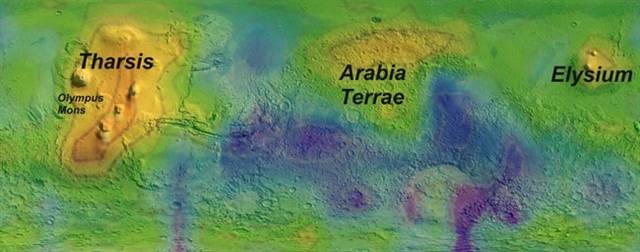Do Seasonal Changes in Mars’s Atmosphere Have a Biological Cause?
Methane disappears and regenerates every year, according to new study

Methane concentrations on Mars change with the seasons as well as location, and the gas disappears within a Martian year, according to a new study by Italian scientists. The finding, developed over five Earth years using NASA’s Mars Global Surveyor, adds to the ongoing debate about the nature of CH4 on Mars.
Methane peaks during the fall in three regions: Tharsis, Elysium and Arabia Terrae. The biggest volcanoes on Mars are in Tharsis and Elysium, and vast amounts of water ice are buried beneath the sands of Arabia Terrae. Methane concentrations drop during winter, and grow so strong in summer that the gas spreads throughout Mars’ thin atmosphere, according to Discovery News.
Scientists led by Sergio Fonti of Italy’s Universita del Salento studied about 3 million observations from the Mars Global Surveyor between July 1999 and October 2004, which is about three Mars years. They found that once emitted, methane only lasts about a year. Then something replenishes it and the cycle starts again.
Scientists have known for about seven years that Mars harbors methane, and that its presence changes over time and place. But the new research shows Mars’ methane cycle is much quicker than scientists thought.
Scientists and the public get excited about extraterrestrial methane because it’s usually produced one or two ways — through volcanic eruptions and biological processes. It is prevalent in the atmospheres of Jupiter, Saturn, Neptune and Uranus, and more recently, scientists figured out it also exists (with some interesting variation) on Saturn’s moon Titan.
Chemical processes could also produce methane, such as carbon dioxide combining with melted water beneath the surface.
Though detection of methane is not a smoking gun for life, changes in the presence of methane are intriguing. Methane breaks down in ultraviolet radiation from the sun, which means something on Mars is replenishing it. The methane’s seasonality and variable location rules out cosmic ray or meteorite bombardment, as Fonti told Discovery News.
What’s more, in the Titan study and this study, solar radiation is not enough to account for all the missing methane. As Fonti says, biological processes could be one of a few possible explanations.
Mars’ methane concentrations are still paltry — at peak times, it’s still only 4 percent of the average methane concentration on Earth, Space.com points out.
Fonti and the other researchers presented their findings last week at the European Planetary Science Congress in Rome.